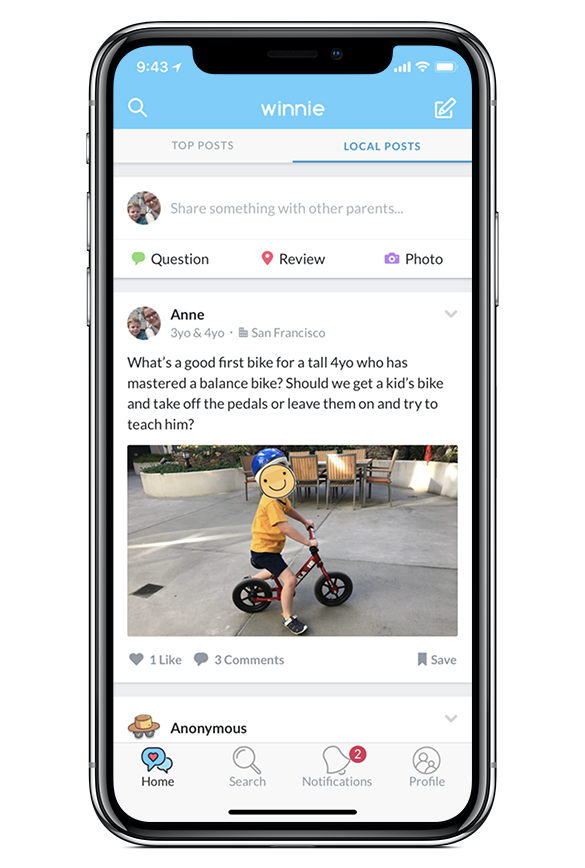Parents are changing and technology isn’t keeping up.

Throughout my career designing and building consumer tech products, I have heard the line “make sure the product is simple enough that even your mom can use it.” This seemingly innocuous phrase has contributed to the long-running stereotype in tech that parents, especially moms, are tech novices and have no idea how to operate a smartphone.
To those who subscribe to this stereotype, I have news for you. 90% of new parents today are millennials. Millennials who, like myself, have grown up most of their lives with technology. They are the savviest of app users and the ones who spend the most time using digital products. In 2017, Millennials spent on average of 223 minutes per day using mobile devices and 71% of Millennial parents say they turn to the internet for parenting advice. Parents today live and breathe technology.
As the co-founder and CEO of Winnie, an app for parents, I think a lot about how to build products that resonate with this new generation of parents. You’re not building a product that’s so simple even your mom can use. Instead you’re building for a demo that has high expectations, limited tolerance, and plenty of other demands on their time. Your margin for error is slim.
Here what’s to keep in mind when designing a product for millennial parents.
Design for convenience
Because millennials have grown up with technology, they are used to everything being a swipe, tap, or click away. Information, food, clothing, their friends — everything is available at their fingertips. That’s why when it came to providing info to parents and answering their questions, it’s really critical that we get parents answered fast. We build this into Winnie from the beginning. You can find a changing table or a place to nurse when you’re out and about. The nearest playground is 1 tap away. Our feed, where people post questions and ask for info, was a part of our product that was introduced once we had a critical mass of users because we knew it would be important that when someone posted something they got an answer almost instantaneously.

User feedback is critical
Just like building any product, you want to get feedback from your users early and often. This is especially important when designing for millennial parents as typical assumptions about parenting don’t necessarily hold true for this generation. For example, before building Winnie we were concerned some parents would not want to share anything relating to their children online. After talking to parents through surveys and interviews, we found that parents — especially millennial parents — craved a place where they could share online, they just wanted it to be a separate space from where they share their life’s highlight reel and they wanted to have privacy controls. We built in privacy features from the start like the ability for people to post questions anonymously, and mask faces in photos. But what we found is that when parents have access to these controls, they are comfortable sharing all kinds of information. We’ve seen parents use Winnie to get help escaping abusive situations and on a lighter note, get the answers to their burning questions they can’t get anywhere else.
Don’t assume parents are moms
From the beginning we designed Winnie for all parents — moms and dads — because increasingly with the millennial generation, dads are taking on a bigger role in parenting. So many parenting products are “mom branded” and millennials aren’t standing for it. Brands that market exclusively to moms look outdated and regressive. Winnie reflects all different genders, ethnicities, and family structures in our branding and as a result we’ve seen this reflected in our user base. We have users of all shapes, sizes and colors in over 3,000 cities across the United States.
Remember that everyone is different
One of our mottos at Winnie is “all parents are different”. Some parents are married and others are single. Some struggle with sleep training and others struggle with potty training. Some breastfeed and others give a bottle. With that in mind, personalization becomes critical. You want to hear from parents who can relate to your situation — parents who live near you, share similar interests, or at a similar life stage. This generation has been using Facebook most of their adult lives so they expect that when they see a feed of content that the feed is relevant and personalized.
Most importantly, go build something
There are very few technology products being built for specifically for parents. Top tech companies like Facebook and Google have massive audiences of millennials but are largely ignoring their new needs as parents. At Winnie we’ve been able to tap into this market and are finding that we are able to grow explosively because it’s a green field and our users are looking for well-designed solutions. But we’re not just building Winnie because of all the opportunity, we’re building it because we want to help parents raise the next generation of humans. What could be more important than that?

Change is the only constant, so individuals, institutions, and businesses must be Built to Adapt. At Pivotal, we believe change should be expected, embraced and incorporated continuously through development and innovation, because good software is never finished.

Designing for Millennial Parents was originally published in Built to Adapt on Medium, where people are continuing the conversation by highlighting and responding to this story.






















